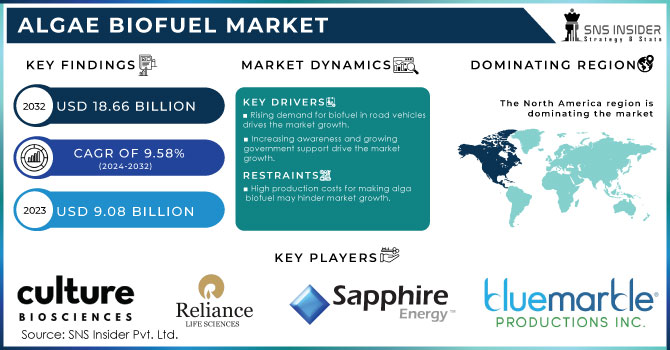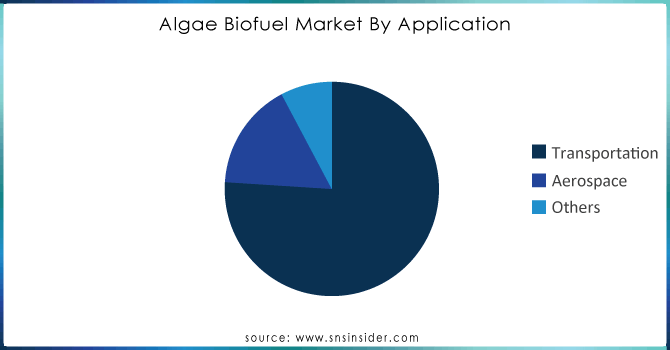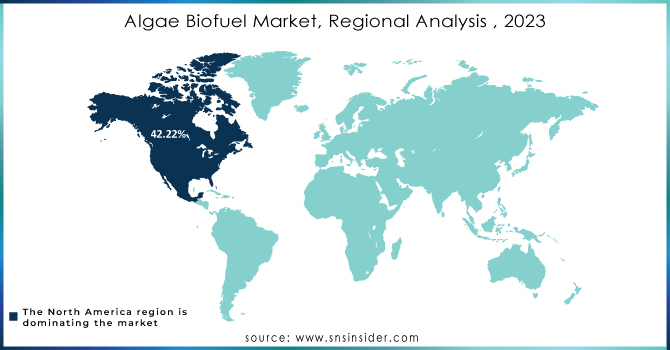Algae Biofuel Market Report Scope & Overview:

Get More Information on Algae Biofuel Market - Request Sample Report
The Algae Biofuel Market Size was valued at USD 9.08 billion in 2023 and is expected to reach USD 18.66 billion by 2032 and grow at a CAGR of 9.58% over the forecast period 2024-2032.
The Algae Biofuel Market is growing and advances in algae cultivation and processing technologies have improved the efficiency and cost-effectiveness of algae biofuels. Innovations such as high-yield algae strains and more efficient extraction methods are making algae biofuels more competitive These techniques include closed-loop systems that minimize water usage while maximizing yield. In addition, scientists are on a mission to identify and engineer algae strains that boast superior qualities, such as higher oil content, faster growth rates, and improved tolerance to diverse environments.
Moreover, increased investment from both private and public sectors into research and development of algae biofuels is accelerating innovation and commercialization. This includes funding for pilot projects and scaling up production facilities.
For instance, TerraVia secured USD 150 million in funding from both private investors and government grants to advance its algae-based biofuel technologies. The investment is focused on scaling up production facilities and improving algae cultivation methods.
Furthermore, government support is also driving the market. Many governments are taking action by implementing policies and offering attractive incentives, such as grants and tax breaks, to propel research and development of algae biofuels forward. These measures not only foster innovation but also help improve the initial challenges associated with production costs. For Example, in April 2024, the U.S. Department of Energy announces USD 18.8 million in mixed algae development for less carbon bioproducts and biofuels.
Market Dynamics
Drivers
-
Rising demand for biofuel in road vehicles drives the market growth.
The algae biofuel market for road vehicles is experiencing a surge in demand, driven by a powerful interplay of environmental and economic forces. Environmental concerns are at the forefront, as growing awareness of climate change and air pollution compels the search for cleaner alternatives. Biofuels, especially those derived from sustainable sources, offer significant reductions in greenhouse gas emissions compared to traditional gasoline and diesel. Governments are also stepping up their game with policies and incentives that promote biofuel use. These can take the form of mandates for blending biofuels with gasoline and diesel, tax breaks for producers and consumers, and crucial investments in research and development of next-generation biofuels.
Furthermore, technology is another key driver, with advancements in biofuel production techniques leading to increased efficiency and cost-effectiveness. The development of second-generation biofuels derived from non-food sources like algae and waste materials addresses concerns about competition with food production.
-
Increasing awareness and growing government support drive the market growth.
Growing consumer awareness of environmental issues is driving the demand for the algae biofuel market. Consumers are accepting renewable energy sources more and more as an alternative to traditional fossil fuels as information on their benefits grows. Governments are responding to this shift in consumer behavior by implementing laws that promote the usage and production of renewable energy. These incentives cover a wide range of actions, from vital investments in research and development of innovative technology to providing the best quality product for both producers and consumers.
Moreover, according to the National Renewable Energy Laboratory, several government funding is empowering research organizations to refine microalgae production techniques. This public backing, coupled with the global drive for clean technologies, is igniting a surge of private-sector investment in microalgae. More than 100 companies, from established giants to nimble startups, are channeling resources into building demonstration plants, exploring microalgae as a feedstock, and optimizing production processes. This confluence of public and private sector investment underscores the burgeoning interest in and potential of microalgae technology.
Restrain
-
High production costs for making algae biofuel may hinder market growth.
High production costs for making algae biofuel can significantly hinder market growth by limiting its competitiveness compared to conventional fossil fuels and other biofuels. The process of cultivating algae, harvesting, and converting it into biofuel involves complex and costly technologies, such as maintaining optimal growth conditions in photobioreactors, extracting oil, and refining the product. These high costs are primarily due to the need for specialized equipment, energy-intensive processes, and the scale-up challenges associated with algae cultivation. This economic barrier can slow the adoption of algae biofuels, impacting the overall market growth and hindering the transition to more sustainable energy solutions.
Market segmentation
By Type
The bioethanol held the largest market share around 32.22% in the overall type segment in 2023. Algae bioethanol is rapidly emerging as a sustainable champion within the biofuel arena. Unlike conventional bioethanol sources like corn and sugarcane, which put pressure on food production by competing for land, algae offer a game-changing advantage. They bloom on non-arable land, amplifying their environmental benefits by leaving food crops undisturbed. Moreover, government backing, through biofuel mandates and incentives, is further propelling the growth of the algae bioethanol sector. Scientists are relentlessly optimizing algae strains, cultivation techniques, and fermentation processes to squeeze out even greater bioethanol yields and enhance overall production efficiency. As the demand for sustainable solutions skyrockets, algae bioethanol is poised to take center stage, playing a critical role in meeting renewable energy targets and significantly reducing the carbon footprint associated with transportation fuels, paving the way for a cleaner future.
By Application
The Transportation segment held the largest revenue share around 76.02% in the application segment 2023 in the algae biofuel market. Algae biofuels significantly reduce greenhouse gas emissions compared to fossil fuels, offering a breath of fresh air for the planet. They are processed into biodiesel for trucks, buses, and ships, and bioethanol for cars, seamlessly blending with gasoline. Furthermore, unlike corn ethanol, algae biofuels don't compete with food production for land. This trifecta of environmental benefits, versatility, and sustainability is propelling the transportation segment forward. As technology advances and costs decrease, algae biofuels have the potential to become the fuel of choice for a cleaner transportation future.

Need any customization research on Algae Biofuel Market- Enquiry Now
Regional Analysis
North America held the largest market share of 42.22% in 2023 in the algae biofuel market due to the bioethanol demand being on a sharp upward trajectory, fueled by a growing awareness of environmental issues and regulations implemented by governments. The oil industry's inherently volatile nature, characterized by price fluctuations, is presenting a unique opportunity for investment in alternative fuel technologies across North America. Among these alternatives, algae bioethanol is rapidly gaining traction, capturing investor attention due to its immense potential. Recognizing this potential, manufacturers are channeling significant resources into research and development endeavors. Their relentless pursuit is to unlock the full photosynthetic efficiency of algae strains, thereby maximizing algae oil extraction. Algae oil is the linchpin of bioethanol production, and these advancements are expected to have a significant positive impact on the market's growth.
Moreover, a critical tailwind comes from the U.S. government's strategic policy shift. By mandating a transition away from biofuels derived from food crops like corn and towards microalgae-based options, the government is actively playing a pivotal role in fostering the growth of the algae biofuel market in North America. In essence, a combination of high demand, a dynamic oil market, relentless focus on R&D efficiency, and supportive government policies is painting a rosy picture for the future of the algae biofuel market in North America.
Asia Pacific is expected to rise at the fastest CAGR during the forecast period. Owing to the growing investments by private and public organizations in bio-based energy sources in Japan, India, and China are expected to grow in upcoming times.

Key Players
Blue Marble Productions, Inc., Sapphire Energy, Culture Biosystems, Algae Systems, LLC., Reliance Life Sciences, Solix, AlgaEnergy, Origin Oils, Genifuel Corporation, Infinita Renovables SA, Culture BioSystems, Lgenol, Neste, and Others.
Recent Development:
-
In January 2024, Hutan Bio, a biotech company has secured the investment from the Clean Growth Fund. It invested USD 2.82 million in the company to accelerate the commercial use of its biofuel oil and so reduce greenhouse gas emissions.
-
In September 2023, EEL Biofuels announced an innovation in renewable energy technology viable algae-based biofuels with the development of its algae-based biofuels. This technology has helped to increase the energy sector by providing traditional fossil fuel alternatives.
-
In June 2023, BASF SE and Avient Corporation partnered to launch colored grades of Ultra Son high-performance polymers worldwide. This collaboration aimed to provide pre-colored solution and color solution with enhanced the option of high quality, and customized polymer solutions in various application.
| Report Attributes | Details |
| Market Size in 2023 | US$ 9.08 Billion |
| Market Size by 2032 | US$ 18.66 Billion |
| CAGR | CAGR of 9.58 % From 2024 to 2032 |
| Base Year | 2023 |
| Forecast Period | 2024-2032 |
| Historical Data | 2020-2022 |
| Report Scope & Coverage | Market Size, Segments Analysis, Competitive Landscape, Regional Analysis, DROC & SWOT Analysis, Forecast Outlook |
| Key Segments | • By Type (Jet Fuel, Bioethanol, Biodiesel, Bio-Gasoline, Bio-Butanol, Methane, Green Diesel, Others) • By Application (Transportation, Aerospace, and Others) |
| Regional Analysis/Coverage | North America (US, Canada, Mexico), Europe (Eastern Europe [Poland, Romania, Hungary, Turkey, Rest of Eastern Europe] Western Europe] Germany, France, UK, Italy, Spain, Netherlands, Switzerland, Austria, Rest of Western Europe]), Asia Pacific (China, India, Japan, South Korea, Vietnam, Singapore, Australia, Rest of Asia Pacific), Middle East & Africa (Middle East [UAE, Egypt, Saudi Arabia, Qatar, Rest of Middle East], Africa [Nigeria, South Africa, Rest of Africa], Latin America (Brazil, Argentina, Colombia, Rest of Latin America) |
| Company Profiles | Blue Marble Productions, Inc., Sapphire Energy, Culture Biosystems, Algae Systems, LLC., Reliance Life Sciences, Solix, AlgaEnergy, Origin Oils, Genifuel Corporation, Infinita Renovables SA, Culture BioSystems, Lgenol, Neste, and Others. |
| Key Drivers | • Rising demand for biofuel in road vehicles drives the market growth |
| RESTRAINTS | •High production costs for making algae biofuel may hinder market growth |

